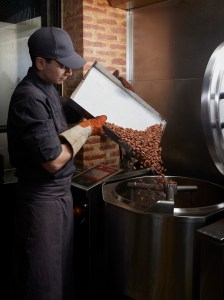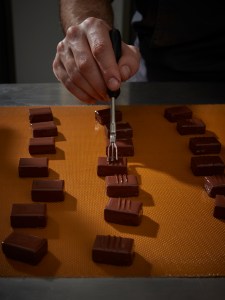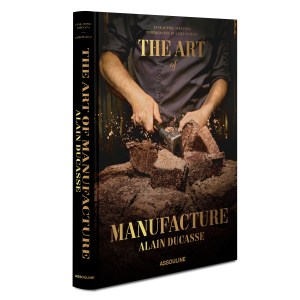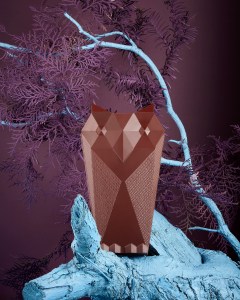When you push open the doors of Alain Ducasse’s new chocolate workshop in Paris, the first thing that hits you is the smell. The rich scent is all-enveloping and provides a warm olfactory counterpoint to the thrumming of machines in a succession of rooms where technicians oversee the transformation of cocoa beans into chocolate.
They are roasted, crushed and mixed, each step controlled with chemical precision. That’s what sets Ducasse apart: where other chefs purchase the raw material for their confectionery, he makes his chocolate from scratch. Just don’t call it a chocolate factory. And Ducasse is no Willy Wonka.
“This is really high craftsmanship,” says the Michelin-starred chef, whose name is synonymous with French gastronomy.
Over breakfast at Le Meurice, the Paris luxury hotel where he’s been head chef for a decade, Ducasse leafs through a coffee table book dedicated to the lavishly appointed labs where he produces not just chocolate but also coffee, ice cream and biscuits, in a thriving sideline for the busy restaurateur.
He works in small batches, preferring to operate from a network of “manufactures” in Paris rather than one large production site in the suburbs. “It’s not a chain, it’s an atelier. We’re more Hermès than Toyota,” he says.

The winnowing machine crushes the bean to separate the outer shell from the nib, the part used to make the chocolate.
© Laziz Hamani/Courtesy of Assouline
The tome published by Assouline this fall, titled “The Art of Manufacture: Alain Ducasse,” features photographs by Laziz Hamani, the still life photographer behind a series of monographs dedicated to Dior’s successive creative directors.
“He photographed the machines as if they were haute couture,” marvels Ducasse, who has a special place in his heart for the beauty on page 43: a roasted cocoa bean crusher from the 1950s.
“We have a guy who looks after it like an old Bentley,” he says. “It’s the rarest object. This is what makes the difference.”
Ducasse is so worried his prized possession will break down, he took the machine apart two years ago and scanned its 1,000 parts to make an exact copy. “It costs a small fortune, but I’m going to have another one made,” he says.
A keen antiques collector, the chef sourced much of the decor for his network of 42 stores and workshops, of which 29 are in France, five in the rest of Europe and eight in Japan. His products are not yet sold in the U.S., making them the ultimate holiday souvenir.
Ducasse likes to mix vintage designs with more contemporary pieces, such as stools designed by Ronan and Erwan Bouroullec. “There’s always a touch of modernity,” he says.
“This is a table from the Bank of France from 1880 that’s been turned into a chocolate display case,” he explains of a photograph of his inaugural chocolate manufacture in Paris, which opened 10 years ago and set the template for the rest with its cast iron and steel structure, concrete floors, brick walls and frosted glass partitions. “That’s a little gem worth 65,000 euros, just to present chocolates,” Ducasse says gleefully.

Rigor is key throughout the manufacturing process, whether the artisans are making a 75 percent dark chocolate or praline preparations.
© Laziz Hamani/Courtesy of Assouline
Obsessive attention to detail runs throughout his organization. On a tour of the new chocolate facility, located in the French capital’s 20th arrondissement, Quentin Francis-Gaigneux, head of production at Le Chocolat Alain Ducasse, explains each step of the process, starting with the selection of cocoa beans harvested at perfect maturity.
“Ten years ago, we didn’t have this quality of beans,” he says. “Gradually we became more selective and started turning down batches of beans. Our quality improved and so did the quality of our suppliers.”
Everything about Ducasse’s chocolates is expensive. Amid soaring cocoa prices, he shells out up to $19,800 per ton for the choicest beans and only works with organic cane sugar, which is four times as expensive as beet sugar, Francis-Gaigneux explains. The chef invested 4.5 million euros in the new manufacture, which is 10 times larger than its predecessor.
Ducasse sees his workshops as laboratories for research, rooted in artisanal techniques stretching back to the 19th century. His ice cream flavors include bread and olive, and he also makes a sorbet with fresh herbs.
The chocolates, whose fans include fashion designer Gabriela Hearst, retail from 20 euros for a box of 12. Christmas specials include a faceted chocolate owl, lined with a thick layer of hazelnut praline, while his Easter chocolates are molded inside real egg shells.
Ducasse, who holds the current world record with 20 Michelin stars, also oversees 34 restaurants worldwide, runs cookery schools and publishes books under his own imprint. “I’ve decided to pass on everything I believe in, to as many people as possible, in every way I can,” the 67-year-old says.
“To this day, 2,000 students have been taught French cooking according to Ducasse, so that’s 2,000 ambassadors out there,” adds the chef, who is set to open his eighth school in Abu Dhabi in December. “For example, there’s a street in Manila that is full of our people — the guys who run the bar, the café and the restaurant — because we were the first cookery school in the Philippines.”

“The Art of Manufacture: Alain Ducasse” published by Assouline.
Courtesy of Assouline
The central tenet of his philosophy is naturality. He has offered a vegetarian menu at his three-Michelin star Monte Carlo restaurant, Le Louis XV — Alain Ducasse à l’Hôtel de Paris, since its opening in 1987.
“We sold two per day. Can you imagine?” he says, recalling that in those days, vegetarian food was “for sick people.” In the meantime, his Mediterranean cuisine has conquered foodies and a third of customers now opt for the “Jardin” menu, which costs 280 euros.
Ducasse believes that good food should be accessible to all, so in 2021, he opened Sapid, a plant-based eatery in Paris where lunch menus start at 22 euros. And last summer, he took part in Lolla Chef, a street food fair on the sidelines of the Lollapalooza Paris music festival.
Nonetheless, he argues that high gastronomy comes at a cost, a fact that is not always well understood in the birthplace of haute cuisine. Ducasse reckons that top chefs could learn a thing or two from luxury brands.
“I think we’re not expensive enough, and we’re not perceived in the same way as haute couture,” he says. “Nobody complains about the price of fashion. People always complain about the price of restaurants, even though haute gastronomy requires just as much labor as haute couture.”
As co-president of the Collège Culinaire de France, an industry body founded by leading chefs, Ducasse is talking to fashion representatives about how to increase synergies between the two sectors, which contribute to France’s reputation as a global leader in luxury. “We have to build bridges between fashion and gastronomy,” he says.

A chocolate owl from Le Chocolat Alain Ducasse.
Courtesy of Alain Ducasse
Within his own industry, he’s focused on spotlighting new talents. Ducasse no longer cooks himself, instead appointing a cadre of young chefs to helm his restaurants. “I provide inspiration. I’m an artistic director,” he says.
In a sector that remains male-dominated, he’s promoted a number of female chefs, including Kelly Jolivet at Benoit, Lisa Desforges at Allard and Victoria Boller at Aux Lyonnais. “I find that even if they are classically trained in haute cuisine, women’s cooking is more sensitive where men focus more on technique,” he says.
His protégés also include Cédric Grolet, his pastry chef at Le Meurice, whose mouthwatering videos have won him 8.8 million followers on Instagram and generate long lines in front of his Paris store.
Ducasse even champions Jean Imbert, who controversially replaced him as head chef of the Plaza Athénée hotel in 2021 with a menu that includes sweetbreads and venison. The “Top Chef” winner, who runs several restaurants with Pharrell Williams, is a favorite of celebrities including Beyoncé and Jay-Z.
“I was the one who suggested Jean Imbert because that way at least there’s a proper break. Why not dare to change?” Ducasse says with a shrug. “It’s a completely different proposition and there is an audience for each.”
Still, he hasn’t given up the hope of converting more people to plant-based cooking, which he believes will be key for the planet’s survival. In September, Ducasse presided over the first Sustainable Gastronomy Summit in Monaco, which gathered chefs, scientists and producers.
“Everyone must do their part and become aware that we must change the way we eat. First of all, we need to put a stop to waste and eat as close to home as possible,” he says. “If we feed individuals better, the planet will be better off and that will nourish peace.”
This post was originally published on this site be sure to check out more of their content.








